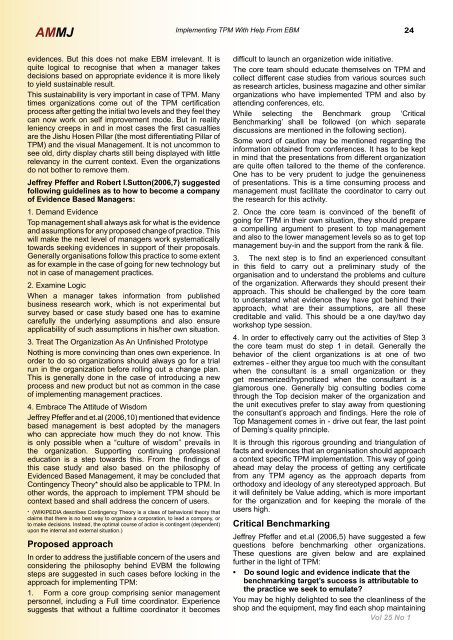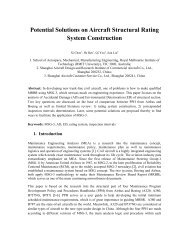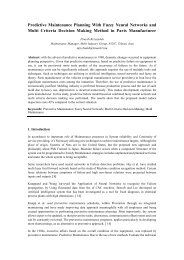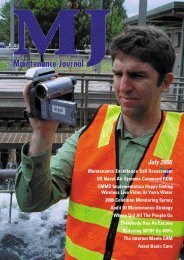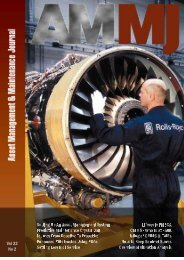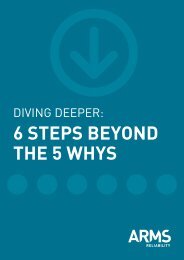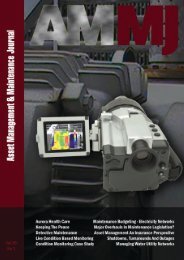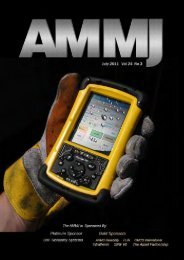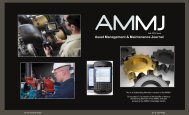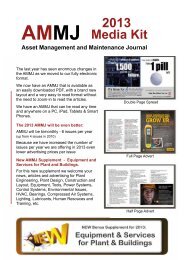The Why, What, How & Who Of Maintenance - AMMJ
The Why, What, How & Who Of Maintenance - AMMJ
The Why, What, How & Who Of Maintenance - AMMJ
- No tags were found...
You also want an ePaper? Increase the reach of your titles
YUMPU automatically turns print PDFs into web optimized ePapers that Google loves.
<strong>AMMJ</strong>Implementing TPM With Help From EBM 24evidences. But this does not make EBM irrelevant. It isquite logical to recognise that when a manager takesdecisions based on appropriate evidence it is more likelyto yield sustainable result.This sustainability is very important in case of TPM. Manytimes organizations come out of the TPM certificationprocess after getting the initial two levels and they feel theycan now work on self improvement mode. But in realityleniency creeps in and in most cases the first casualtiesare the Jishu Hosen Pillar (the most differentiating Pillar ofTPM) and the visual Management. It is not uncommon tosee old, dirty display charts still being displayed with littlerelevancy in the current context. Even the organizationsdo not bother to remove them.Jeffrey Pfeffer and Robert I.Sutton(2006,7) suggestedfollowing guidelines as to how to become a companyof Evidence Based Managers:1. Demand EvidenceTop management shall always ask for what is the evidenceand assumptions for any proposed change of practice. Thiswill make the next level of managers work systematicallytowards seeking evidences in support of their proposals.Generally organisations follow this practice to some extentas for example in the case of going for new technology butnot in case of management practices.2. Examine LogicWhen a manager takes information from publishedbusiness research work, which is not experimental butsurvey based or case study based one has to examinecarefully the underlying assumptions and also ensureapplicability of such assumptions in his/her own situation.3. Treat <strong>The</strong> Organization As An Unfinished PrototypeNothing is more convincing than ones own experience. Inorder to do so organizations should always go for a trialrun in the organization before rolling out a change plan.This is generally done in the case of introducing a newprocess and new product but not as common in the caseof implementing management practices.4. Embrace <strong>The</strong> Attitude of WisdomJeffrey Pfeffer and et.al (2006,10) mentioned that evidencebased management is best adopted by the managerswho can appreciate how much they do not know. Thisis only possible when a “culture of wisdom” prevails inthe organization. Supporting continuing professionaleducation is a step towards this. From the findings ofthis case study and also based on the philosophy ofEvidenced Based Management, it may be concluded thatContingency <strong>The</strong>ory* should also be applicable to TPM. Inother words, the approach to implement TPM should becontext based and shall address the concern of users.* (WIKIPEDIA describes Contingency <strong>The</strong>ory is a class of behavioral theory thatclaims that there is no best way to organize a corporation, to lead a company, orto make decisions. Instead, the optimal course of action is contingent (dependent)upon the internal and external situation.)Proposed approachIn order to address the justifiable concern of the users andconsidering the philosophy behind EVBM the followingsteps are suggested in such cases before locking in theapproach for implementing TPM:1. Form a core group comprising senior managementpersonnel, including a Full time coordinator. Experiencesuggests that without a fulltime coordinator it becomesdifficult to launch an organizetion wide initiative.<strong>The</strong> core team should educate themselves on TPM andcollect different case studies from various sources suchas research articles, business magazine and other similarorganizations who have implemented TPM and also byattending conferences, etc.While selecting the Benchmark group ‘CriticalBenchmarking’ shall be followed (on which separatediscussions are mentioned in the following section).Some word of caution may be mentioned regarding theinformation obtained from conferences. It has to be keptin mind that the presentations from different organizationare quite often tailored to the theme of the conference.One has to be very prudent to judge the genuinenessof presentations. This is a time consuming process andmanagement must facilitate the coordinator to carry outthe research for this activity.2. Once the core team is convinced of the benefit ofgoing for TPM in their own situation, they should preparea compelling argument to present to top managementand also to the lower management levels so as to get topmanagement buy-in and the support from the rank & file.3. <strong>The</strong> next step is to find an experienced consultantin this field to carry out a preliminary study of theorganisation and to understand the problems and cultureof the organization. Afterwards they should present theirapproach. This should be challenged by the core teamto understand what evidence they have got behind theirapproach, what are their assumptions, are all thesecreditable and valid. This should be a one day/two dayworkshop type session.4. In order to effectively carry out the activities of Step 3the core team must do step 1 in detail. Generally thebehavior of the client organizations is at one of twoextremes - either they argue too much with the consultantwhen the consultant is a small organization or theyget mesmerized/hypnotized when the consultant is aglamorous one. Generally big consulting bodies comethrough the Top decision maker of the organization andthe unit executives prefer to stay away from questioningthe consultant’s approach and findings. Here the role ofTop Management comes in - drive out fear, the last pointof Deming’s quality principle.It is through this rigorous grounding and triangulation offacts and evidences that an organisation should approacha context specific TPM implementation. This way of goingahead may delay the process of getting any certificatefrom any TPM agency as the approach departs fromorthodoxy and ideology of any stereotyped approach. Butit will definitely be Value adding, which is more importantfor the organization and for keeping the morale of theusers high.Critical BenchmarkingJeffrey Pfeffer and et.al (2006,5) have suggested a fewquestions before benchmarking other organizations.<strong>The</strong>se questions are given below and are explainedfurther in the light of TPM:• Do sound logic and evidence indicate that thebenchmarking target’s success is attributable tothe practice we seek to emulate?You may be highly delighted to see the cleanliness of theshop and the equipment, may find each shop maintainingVol 25 No 1


